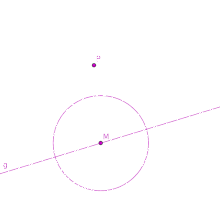Poncelet–Steiner theorem
In Euclidean geometry, the Poncelet–Steiner theorem is one of several results concerning compass and straightedge constructions with additional restrictions. This result states that whatever can be constructed by straightedge and compass together can be constructed by straightedge alone, provided that a single circle and its centre are given.

History
In the tenth century, the Persian mathematician Abu al-Wafa' Buzjani (940−998) considered geometric constructions using a straightedge and a compass with a fixed opening, a so-called rusty compass. Constructions of this type appeared to have some practical significance as they were used by artists Leonardo da Vinci and Albrecht Dürer in Europe in the late fifteenth century. A new viewpoint developed in the mid sixteenth century when the size of the opening was considered fixed but arbitrary and the question of how many of Euclid's constructions could be obtained was paramount.[1]
Renaissance mathematician Lodovico Ferrari, a student of Gerolamo Cardano in a "mathematical challenge" against Niccolò Fontana Tartaglia was able to show that "all of Euclid" (that is, the straightedge and compass constructions in the first six books of Euclid's Elements) could be accomplished with a straightedge and rusty compass. Within ten years additional sets of solutions were obtained by Cardano, Tartaglia and Tartaglia's student Benedetti. During the next century these solutions were generally forgotten until, in 1673, Georg Mohr published (anonymously and in Dutch) Euclidis Curiosi containing his own solutions. Mohr had only heard about the existence of the earlier results and this led him to work on the problem.[2]
Showing that "all of Euclid" could be performed with straightedge and rusty compass is not the same as proving that all straightedge and compass constructions could be done with a straightedge and just a rusty compass. Such a proof would require the formalization of what a straightedge and compass could construct. This groundwork was provided by Jean Victor Poncelet in 1822. He also conjectured and suggested a possible proof that a straightedge and rusty compass would be equivalent to a straightedge and compass, and moreover, the rusty compass need only be used once. The result that a straightedge and single circle with given centre is equivalent to a straightedge and compass was proved by Jakob Steiner in 1833.[3][1]
Other types of restricted construction
The Poncelet–Steiner theorem should be contrasted with the Mohr–Mascheroni theorem, which states that any compass and straightedge construction can be performed with only a compass.
It is not possible to construct everything that can be constructed with straightedge and compass with straightedge alone. If the centre of the only given circle is not provided, it cannot be obtained by a straightedge alone. Many constructions are impossible with straightedge alone. Something more is required, and a circle with its center identified is sufficient.
The requirement that one circle with its center provided has been since generalized to include alternative but equally restrictive conditions. In one such alternative, the entire circle is not required at all. In 1904, Francesco Severi proved that any small arc together with the centre will suffice.[4]
In two other alternatives, both attributed to D. Cauer, the centre may be omitted entirely provided that given are either two concentric circles, or two distinct intersecting circles, of which there are two cases: two intersection points and one intersection point (tangential circles). The tangential case itself has two cases: congruent and non-congruent circles. From any of these scenarios, centres can be constructed, reducing the scenario to the original hypothesis.
Still other variations exist. It suffices to have two non-intersecting circles (without their centres) if a centerline point is provided, two non-intersecting circles (without centres) if a single point on the radial axis is provided, or to simply have three non-intersecting circles.[5]
Notes
- Eves 1963, p.205
- Retz & Keihn 1989, p.195
- Jacob Steiner (1833). Die geometrischen Konstructionen, ausgeführt mittelst der geraden Linie und eines festen Kreises, als Lehrgegenstand auf höheren Unterrichts-Anstalten und zur praktischen Benutzung (in German). Berlin: Ferdinand Dümmler. Retrieved 2 April 2013.
- Retz & Keihn 1989, p. 196
- Wolfram's Math World
References
- Eves, Howard (1963), A Survey of Geometry /Volume one, Allyn and Bacon
- Retz, Merlyn; Keihn, Meta Darlene (1989), "Compass and Straightedge Constructions", Historical Topics for the Mathematics Classroom, National Council of Teachers of Mathematics (NCTM), pp. 192–196, ISBN 9780873532815
Further reading
- Eves, Howard Whitley (1995), "3.6 The Poncelet–Steiner Construction Theorem", College Geometry, Jones & Bartlett Learning, pp. 180–186, ISBN 9780867204759
External links
- Jacob Steiner's theorem at cut-the-knot (It is impossible to find the center of a given circle with the straightedge alone)
- Straightedge alone Basic constructions of straightedge-only constructions.
- Two circles and only a straightedge, an article by Arseniy Akopyan and Roman Fedorov.
- A remark on the construction of the centre of a circle by means of the ruler, by Christian Gram.